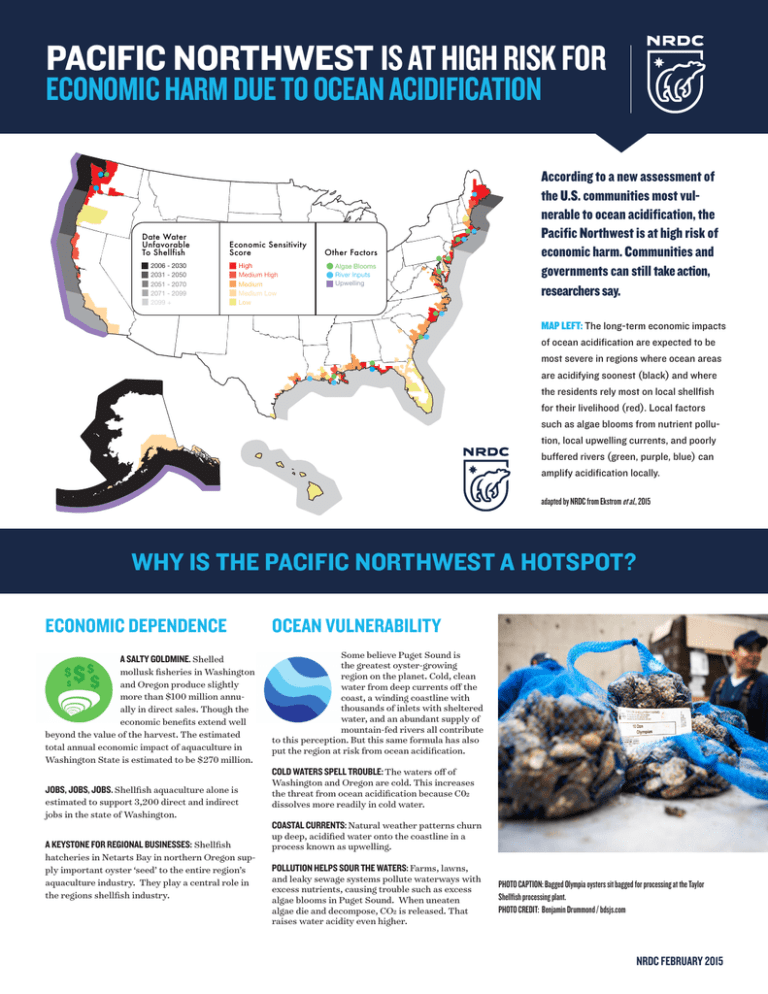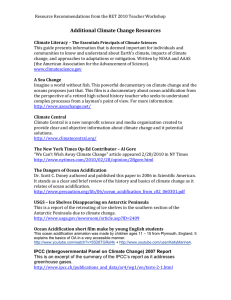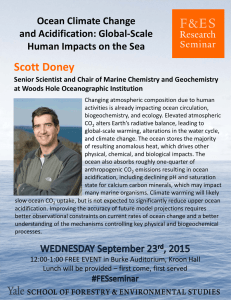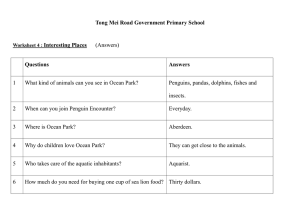NRDC: States Vulnerable to Ocean Acidification
advertisement

PACIFIC NORTHWEST IS AT HIGH RISK FOR ECONOMIC HARM DUE TO OCEAN ACIDIFICATION Date Water Unfavorable To Shellfish 2006 - 2030 2031 - 2050 2051 - 2070 2071 - 2099 2099 + Economic Sensitivity Score High Medium High Medium Medium Low Low According to a new assessment of the U.S. communities most vulnerable to ocean acidification, the Pacific Northwest is at high risk of economic harm. Communities and governments can still take action, researchers say. Other Factors Algae Blooms River Inputs Upwelling MAP LEFT: The long-term economic impacts of ocean acidification are expected to be most severe in regions where ocean areas are acidifying soonest (black) and where the residents rely most on local shellfish for their livelihood (red). Local factors such as algae blooms from nutrient pollution, local upwelling currents, and poorly buffered rivers (green, purple, blue) can amplify acidification locally. adapted by NRDC from Ekstrom et al., 2015 adapted by NRDC from Ekstrom et al., 2015 WHY IS THE PACIFIC NORTHWEST A HOTSPOT? ECONOMIC DEPENDENCE OCEAN VULNERABILITY A SALTY GOLDMINE. Shelled mollusk fisheries in Washington and Oregon produce slightly more than $100 million annually in direct sales. Though the economic benefits extend well beyond the value of the harvest. The estimated total annual economic impact of aquaculture in Washington State is estimated to be $270 million. Some believe Puget Sound is the greatest oyster-growing region on the planet. Cold, clean water from deep currents off the coast, a winding coastline with thousands of inlets with sheltered water, and an abundant supply of mountain-fed rivers all contribute to this perception. But this same formula has also put the region at risk from ocean acidification. JOBS, JOBS, JOBS. Shellfish aquaculture alone is estimated to support 3,200 direct and indirect jobs in the state of Washington. A KEYSTONE FOR REGIONAL BUSINESSES: Shellfish hatcheries in Netarts Bay in northern Oregon supply important oyster ‘seed’ to the entire region’s aquaculture industry. They play a central role in the regions shellfish industry. COLD WATERS SPELL TROUBLE: The waters off of Washington and Oregon are cold. This increases the threat from ocean acidification because C02 dissolves more readily in cold water. COASTAL CURRENTS: Natural weather patterns churn up deep, acidified water onto the coastline in a process known as upwelling. POLLUTION HELPS SOUR THE WATERS: Farms, lawns, and leaky sewage systems pollute waterways with excess nutrients, causing trouble such as excess algae blooms in Puget Sound. When uneaten algae die and decompose, CO2 is released. That raises water acidity even higher. PHOTO CAPTION: Bagged Olympia oysters sit bagged for processing at the Taylor Shellfish processing plant. PHOTO CREDIT: Benjamin Drummond / bdsjs.com NRDC FEBRUARY 2015 WHAT CAN WE DO? WHAT IS OCEAN ACIDIFICATION? THE OCEANS NATURALLY absorb Alaska fishermen send urgent message to save the oceans from ocean acidification. | PHOTO: Lou Dematteis/Spectral Q THE MOST EFFECTIVE STEP toward healthier oceans is to stop pumping carbon dioxide into the sea from cars, factories, and power plants. But Oregon and Washington policymakers—and residents—don’t need to wait for global coordination, researchers say. They can make a difference now: INVEST in shellfish aquaculture techniques to help protect mollusks from corrosive waters during their sensitive larval phase. HELP NATURE cultivate ocean acidification-resistant bivalves by selecting and breeding strains that are naturally more resistant to the ocean changes. INCREASE FUNDING for targeted research and monitoring programs that help protect the shellfish industry such as the National Oceanic and Atmospheric Administration's Sea Grant program and the Federal Ocean Acidification Research and Monitoring program. REDUCE nutrient pollution that flows into waterways through smart farming and carbon dioxide from our atmosphere. Now, however, we’ve tinkered with that equation, dramatically increasing the amount of carbon dioxide entering the ocean through more than a century of burning fossil fuels. When carbon dioxide dissolves into the ocean, it triggers chemical reactions that reduce the pH (increasing its acidity) while also reducing the availability of compounds such as carbonate. Carbonate is crucial because many shellfish and corals need it to build their skeletons and shells. With less of it, organisms expend more energy on shell-building and less on eating and basic survival. This can harm the organism and reduce populations. As ocean acidification accelerates, it now poses a serious threat to the web of life underwater. development techniques and upgraded sewage treatment. More than any state in the nation, Washington has taken action to reduce the impacts of ocean acidification. In 2012, then-Governor Christine Gregoire signed an executive order outlining a plan of action to reduce the harm of ocean acidification to Washington’s marine resources. Many of these recommendations have already been implemented. This effort should continue and be integrated in a larger West-Coast initiative. ABOUT THE STUDY THE FINDINGS ABOUT THE PACIFIC NORTHWEST are contained in a new paper, “Vulnerability and Adaptation of US Shellfisheries to Ocean Acidification,” published today in Nature Climate Change. The study breaks new ground by identifying the communities along our nation’s shores that will most likely suffer long-term economic harm from ocean acidification, revealing a mosaic of vulnerability to ocean acidification nationwide. Coastal communities in 15 states are at high economic risk from ocean acidification due to their dependence on U.S. shelled mollusk fisheries, which brings in $1 billion annually. The researchers urge policymakers to take action now to protect these regions. Researchers studied harvests from shelled mollusks such as oysters, clams, and NRDC FEBRUARY 2015 scallops, which will likely be the first U.S. fisheries harmed by ocean acidification. They mapped locations in the ocean experiencing the most rapid changes from rising CO2 in the atmosphere. They identified places where local factors such as algae blooms contribute to acidification, and mapped coastal communities that would be most vulnerable to declining harvests. Finally, they identified places where all these variables overlapped. This work was supported by the National Socio-Environmental Synthesis Center under funding received from the National Science Foundation DBI-1052875. RAPID DECLINE IN: OCEAN pH OCEAN pH IN 1860 PROJECTED OCEAN pH IN 2100 INFOGRAPHIC: This infographic is part of the Ocean Acidification Summary for Policy Makers – Third Symposium in an Ocean in a High CO2 World sponsored by IGBP, IOC-UNESCO, and SCOR for more information www.igbp.net.




